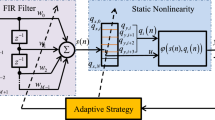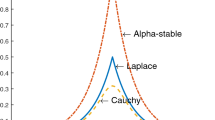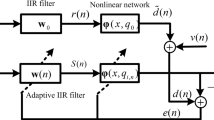Abstract
This study proposes a spline filtering algorithm-based generalized maximum correntropy criterion (GMCC), named the spline adaptive filter (SAF-)-GMCC algorithm. Compared with traditional spline algorithms, the SAF-GMCC can cope with impulsive interference effectively, because the GMCC has a low sensitivity to mutation signals. The GMCC-based variable step-size spline filtering algorithm (SAF-GMCC) is proposed to solve the limitation of the fixed step-size on the SAF-GMCC algorithm’s performance and to improve the convergence rate and steady-state error performance. Combining these algorithms with the active noise control (ANC) model, this study proposes the filtered-c generalized maximum correntropy criterion (FcGMCC) and variable step-size filtered-c generalized maximum correntropy criterion (FcVGMCC) algorithms. Finally, the nonlinear system identification model simulates an experimental environment with impulsive interference. The SAF-GMCC and SAF-VGMCC algorithms offer better robustness than the existing algorithms. And the alpha-stable noise environment simulation with different impact strengths, in the ANC model verifies the FcGMCC and FcVGMCC algorithms’ robustness in nonlinear and non-Gaussian noise environments.








Similar content being viewed by others
Data Availability
The data that support the findings of this study are available from the corresponding author on request.
References
J. Caillec, Spectral inversion of second order volterra models based on the blind identification of wiener models. Signal Process. 91(11), 2541–2555 (2011). https://doi.org/10.1016/j.sigpro.2011.05.007
E. Catmull, R. Rom, A class of local interpolating splines. Comput. Aided Geom. Des. (1974). https://doi.org/10.1016/B978-0-12-079050-0.50020-5
B. Chen, J.C. Principe, J. Hu, Y. Zhu, Stochastic information gradient algorithm with generalized Gaussian distribution model. J Circuits Syst. Comput. (2012). https://doi.org/10.1142/S0218126612500065
B. Chen, L. Xing, H. Zhao, N. Zheng, J.C. Principe, Generalized correntropy for robust adaptive filtering. IEEE Trans. Signal Process. 64(13), 3376–3387 (2015). https://doi.org/10.1109/TSP.2016.2539127
D. Comminiello, M. Scarpiniti, L.A. Azpicueta-Ruiz, J. Arenas-García, A. Uncini, Functional link adaptive filters for nonlinear acoustic echo cancellation. IEEE Trans. Audio Speech Lang. Process. 21(7), 1502–1512 (2013). https://doi.org/10.1109/TASL.2013.2255276
J. Gong, B. Yao, Neural network adaptive robust control of nonlinear systems in semi-strict feedback form. Automatica 37(8), 1149–1160 (2001). https://doi.org/10.1016/S0005-1098(01)00069-3
S. Haykin, Kalman filtering and neural networks, Wiley, (2001)
L. Ji, J. Ni, Sparsity-aware normalized subband adaptive filters with jointly optimized parameters. J. Franklin Inst. 357(17), 13144–13157 (2020). https://doi.org/10.1016/j.jfranklin.2020.09.015
D. Jin, J. Chen, C. Richard, J. Chen, Model-driven online parameter adjustment for zero-attracting LMS. Signal Process. 152, 373–383 (2018). https://doi.org/10.1016/j.sigpro.2018.06.020
X. Li, G.L. Wei, L.C. Wang, Distributed set-membership filtering for discrete-time systems subject to denial-of-service attacks and fading measurements: a zonotopic approach. Inf. Sci. 547, 49–67 (2021). https://doi.org/10.1016/j.ins.2020.07.041
F. Lindsten, T.B. Schon, M.I. Jordan, Bayesian semi-parametric wiener system identification. Automatica 49(7), 2053–2063 (2013). https://doi.org/10.1016/j.automatica.2013.03.021
C. Liu, Z. Zhang, Set-membership normalised least M-estimate spline adaptive filtering algorithm in impulsive noise. Electron. Lett. 54(6), 393–395 (2018). https://doi.org/10.1049/el.2017.4434
C. Liu, Z. Zhang, X. Tang, Sign normalised spline adaptive filtering algorithms against impulsive noise. Signal Process. 148, 234–240 (2018). https://doi.org/10.1016/j.sigpro.2018.02.022
Q. Liu, Y. He, Robust geman-mcclure based nonlinear spline adaptive filter against impulsive noise. IEEE Access. 8, 22571–22580 (2020). https://doi.org/10.1109/ACCESS.2020.2969219
P. Lueg, Process of silencing sound oscillations, U. S. Patent 2043416 (1936)
T. Ogunfunmi, Adaptive nonlinear system identification: the volterra and wiener model approaches (Springer, Berlin, Germany, 2007)
V. Patel, S. Bhattacharjee, N. George, A family of logarithmic hyperbolic cosine spline nonlinear adaptive filters. Appl. Acoust. 178, 107–973 (2021). https://doi.org/10.1016/j.apacoust.2021.107973
S. Peng, Z. Wu, X. Zhang, B. Chen, Nonlinear spline adaptive filtering under maximum correntropy criterion. In TENCON 2015–2015 IEEE Region 10 Conference, IEEE, pp. 1–5 (2015). https://doi.org/10.1109/TENCON.2015.7373051
N. Quaegebeur, A. Chaigne, Nonlinear vibrations of loudspeaker-like structures. J. Sound Vibr. 309, 178–196 (2008). https://doi.org/10.1016/j.jsv.2007.06.040
M. Rasouli, D. Westwick, W. Rosehart, Quasiconvexity analysis of the Hammerstein model. Autom. 50(1), 277–281 (2014). https://doi.org/10.1016/j.automatica.2013.11.004
G. Scarano, D. Caggiati, G. Jacovitti, Cumulant series expansion of hybrid nonlinear moments of n variates. IEEE Trans. Signal Process. 41(1), 486–489 (1993). https://doi.org/10.1109/TSP.1993.193184
M. Scarpiniti, D. Comminiello D, R. Parisi, A. Uncini, Spline adaptive filters: theory and applications//Adaptive learning methods for nonlinear system modeling. Butterworth-Heinemann, 47–69 (2008).
M. Scarpiniti, D. Comminiello, R. Parisi, A. Uncini, Nonlinear spline adaptive filtering. Signal Process. 93(4), 772–783 (2013). https://doi.org/10.1016/j.sigpro.2012.09.021
M. Scarpiniti, D. Comminiello, R. Parisi, A. Uncini, Novel cascade spline architectures for the identification of nonlinear systems. IEEE Trans. Circuits Syst. I-Regul. Pap. 62(7), 1825–1835 (2015). https://doi.org/10.1109/TCSI.2015.2423791
M. Scarpiniti, D. Comminiello, G. Scarano, R. Parisi, A. Uncini, Steady-state performance of spline adaptive filters. IEEE Trans. Signal Process. 64(4), 816–828 (2016). https://doi.org/10.1109/TSP.2015.2493986
A. Singh, J. C. Principe, Using correntropy as a cost function in linear adaptive filters. In 2009 International Joint Conference on Neural Networks (IJCNN), IEEE, pp. 2950–2955 (2009). https://doi.org/10.1109/IJCNN.2009.5178823
S. Talebi, S. Godsill, D. Mandic, Filtering structures for α-stable systems. IEEE Control Syst. Lett. 7, 553–558 (2023). https://doi.org/10.1109/LCSYS.2022.3202827
M. Varanasi, B. Aazhang, Parametric generalized gaussian density estimation. J. Acoust. Soc. Amer. 86(4), 1404–1415 (1989). https://doi.org/10.1121/1.398700
X. Wang, J.H. Park, H. Liu, X. Zhang, Cooperative output-feedback secure control of distributed linear cyber-physical systems resist intermittent DoS attacks. IEEE Trans. Cybernetics. 51(10), 4924–4933 (2021). https://doi.org/10.1109/TCYB.2020.3034374
P. Wen, J. Zhang, S. Zhang, B. Qu, Normalized subband spline adaptive filter: algorithm derivation and analysis. Circuits Syst. Signal Process. 40, 2400–2418 (2021). https://doi.org/10.1007/s00034-020-01577-6
N. Wiener, Extrapolation, interpolation, and smoothing of stationary time series (Wiley, New York, 1964)
J. Zhang, Y. Jiang, X. Li, M. Huo, H. Luo, S. Yin, An adaptive remaining useful life prediction approach for single battery with unlabeled small sample data and parameter uncertainty. Reliab. Eng. Syst. Saf. 222, 0951–8320 (2022). https://doi.org/10.1016/j.ress.2022.108357
J. Zhang, Y. Jiang, X. Li, H. Luo, S. Yin, O. Kaynak, Remaining useful life prediction of Lithium-Ion battery with adaptive noise estimation and capacity regeneration detection. IEEE/ASME Trans. Mechatron. (2022). https://doi.org/10.1109/tmech.2022.3202642
J. Zhang, X. Xiao, Predicting low-dimensional chaotic time series using volterra adaptive filters. Acta Phys. Sin. 49, 403–408 (2000). https://doi.org/10.1016/S0370-2693(00)00081-2
H. Zhao, Y. Gao, Y. Zhu, Robust subband adaptive filter algorithms-based mixture correntropy and application to acoustic echo cancellation. IEEE Trans. Audio Speech Lang. Process. 31, 1223–1233 (2023). https://doi.org/10.1109/TASLP.2023.3250845
H. Zhao, B. Tian, Robust power system forecasting-aided state estimation with generalized maximum mixture correntropy unscented Kalman filter. IEEE Trans. Instrum. Meas. 71, 1–10 (2022). https://doi.org/10.1109/TIM.2022.3160562
H. Zhao, B. Tian, B. Chen, Robust stable iterated unscented kalman filter based on maximum correntropy criterion. Automatica (2022). https://doi.org/10.1016/j.automatica.2022.110410
H. Zhao, W. Xiang, S. Lv, A variable parameter LMS algorithm based on generalized maximum correntropy criterion for graph signal processing. IEEE Tran. Signal Inf. Process. Netw. 9, 140–151 (2023). https://doi.org/10.1109/TSIPN.2023.3248948
S. Zhou, H. Zhao, Statistics variable kernel width for maximum correntropy criterion algorithm. Signal Process. 176, 109589 (2020). https://doi.org/10.1016/j.sigpro.2020.107589
Y. Zhu, H. Zhao, X. He, Z. Shu, B. Chen, Cascaded random fourier filter for robust nonlinear active noise control. IEEE Trans. Audio Speech Lang. Process. 30, 2188–2200 (2022). https://doi.org/10.1109/TASLP.2021.3126943
Y. Zhu, H. Zhao, X. Zeng, B. Chen, Robust generalized maximum correntropy criterion algorithms for active noise control. IEEE Trans. Audio, Speech, Lang. Process. 28, 1282–1292, (2020). https://doi.org/10.1109/TASLP.2020.2982030
Y. Zou, S. Chan, T. Ng, Least mean M-estimate algorithms for robust adaptive filtering in impulse noise. IEEE Trans. Circuits Syst. II Analog Digit. Signal Process. 47(12), 1564–1569 (2000). https://doi.org/10.1109/82.899657
Acknowledgements
This work was partially supported by National Natural Science Foundation of China (Grant Nos: 62171388, 61871461, 61571374) and Fundamental Research Funds for the Central Universities (Grant No: 2682021ZTPY091).
Author information
Authors and Affiliations
Corresponding author
Ethics declarations
Conflict of interest
The authors declare that they have no known competing financial interests or personal relationships that could have appeared to influence the work reported in this paper.
Additional information
Publisher's Note
Springer Nature remains neutral with regard to jurisdictional claims in published maps and institutional affiliations.
Rights and permissions
Springer Nature or its licensor (e.g. a society or other partner) holds exclusive rights to this article under a publishing agreement with the author(s) or other rightsholder(s); author self-archiving of the accepted manuscript version of this article is solely governed by the terms of such publishing agreement and applicable law.
About this article
Cite this article
Gao, Y., Zhao, H., Zhu, Y. et al. Spline Adaptive Filtering Algorithm-based Generalized Maximum Correntropy and its Application to Nonlinear Active Noise Control. Circuits Syst Signal Process 42, 6636–6659 (2023). https://doi.org/10.1007/s00034-023-02411-5
Received:
Revised:
Accepted:
Published:
Issue Date:
DOI: https://doi.org/10.1007/s00034-023-02411-5




